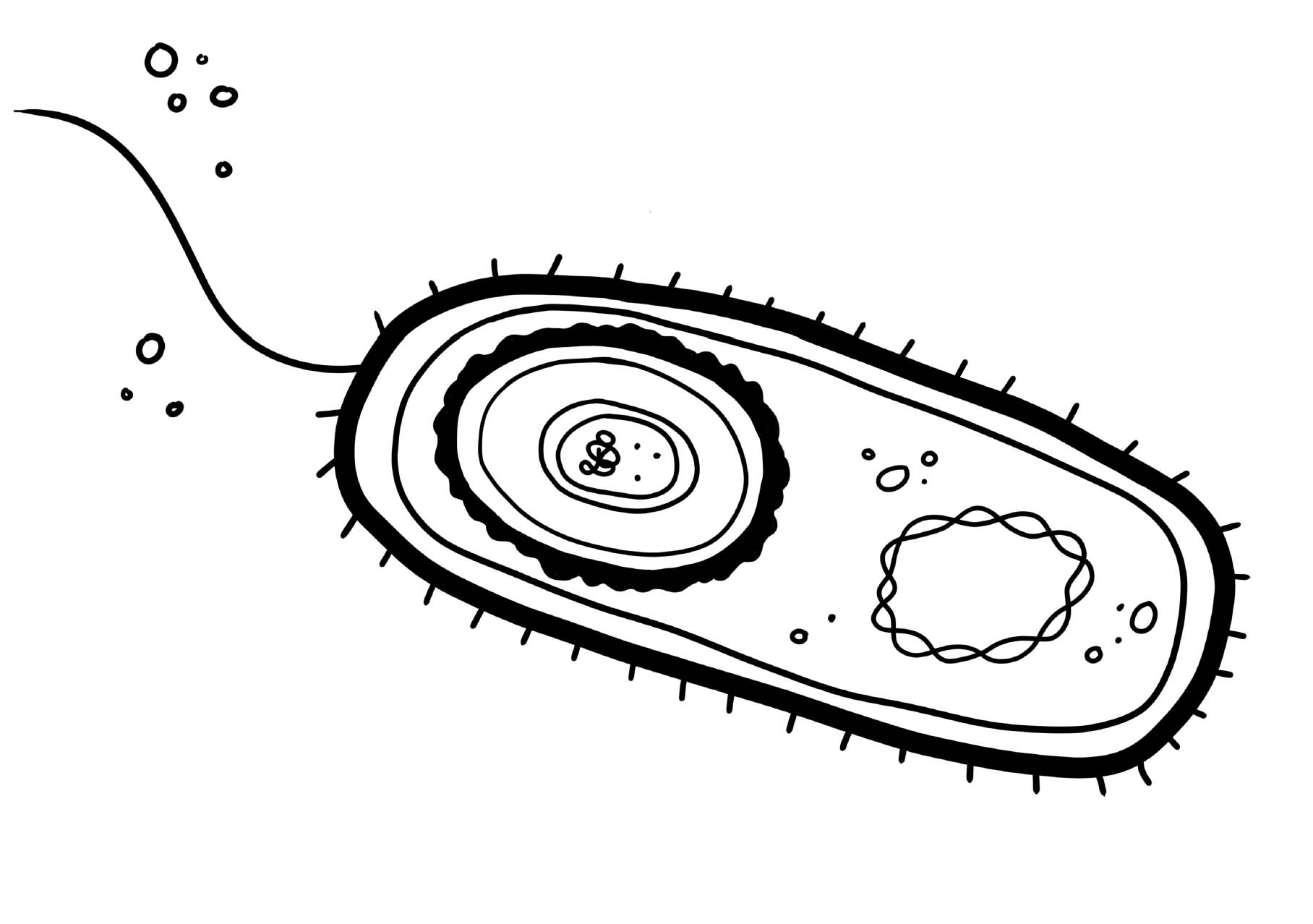Home>Garden Essentials>What Causes An Endospore To Germinate?


Garden Essentials
What Causes An Endospore To Germinate?
Modified: March 16, 2024
Discover what causes an endospore to germinate in the garden. Explore the factors and processes involved in the fascinating process of endospore germination.
(Many of the links in this article redirect to a specific reviewed product. Your purchase of these products through affiliate links helps to generate commission for Storables.com, at no extra cost. Learn more)
Introduction
Gardening is a beautiful and rewarding hobby that allows us to connect with nature and create stunning outdoor spaces. Whether you are a seasoned gardener or just getting started, having a deep understanding of plants and their needs is crucial for success. And one key aspect of plant growth and development is the germination process.
In the plant world, germination refers to the process by which a seed begins to grow and develop into a new plant. It is a complex series of events triggered by specific environmental cues and internal factors within the seed itself. Understanding the process of germination is essential for gardeners, as it can greatly impact the success of their plantings.
When it comes to the germination of seeds, one intriguing phenomenon that stands out is the germination of endospores. Endospores are a specialized type of dormant structure formed by certain bacteria and fungi. These structures are incredibly resilient and can withstand extreme conditions, such as heat, cold, and desiccation. They serve as a survival mechanism, allowing organisms to remain dormant until more favorable conditions for growth and reproduction arise.
The germination of endospores is a fascinating process that involves the transition from a dormant state to an actively growing organism. By understanding the factors that trigger endospore germination and the mechanisms that drive it, we can gain insights into the resilience and adaptability of these remarkable organisms.
This article aims to explore the causes of endospore germination and shed light on the various environmental factors that influence this process. We will also delve into the mechanisms behind endospore germination and discuss its significance in different industries. Lastly, we will touch upon the challenges associated with studying endospore germination and highlight areas of future research in this field.
Key Takeaways:
- Endospore germination is a fascinating process that allows resilient organisms to transition from dormancy to active growth, offering potential applications in agriculture, food production, and disease control.
- Understanding the triggers and mechanisms of endospore germination can lead to innovative solutions for challenges in biotechnology, medicine, and environmental management, unlocking new possibilities for sustainable development.
Read more: What Causes Endospores To Germinate
Definition of an Endospore
An endospore is a unique and highly resistant structure formed by certain bacteria and fungi in response to unfavorable environmental conditions. It acts as a protective shield, allowing the organism to remain dormant and survive until conditions become more favorable for growth and reproduction.
The formation of an endospore begins when a cell undergoes a process called sporulation. During sporulation, the cell undergoes a series of morphological and biochemical changes to transform into an endospore. This process occurs within the cytoplasm of the cell and involves the synthesis and deposition of specialized proteins and other molecules.
Endospores are renowned for their exceptional resistance to harsh conditions that would normally be detrimental to the survival of the organism. They can withstand extremes of temperature, pressure, radiation, and desiccation. The protective outer layers of the endospore provide a shield against the damaging effects of these environmental stressors.
The formation of an endospore is a highly regulated process and is triggered by specific environmental cues, such as nutrient depletion or the presence of harmful substances. Once the cues are sensed, the cell initiates the sporulation process, leading to the development of an endospore.
It is important to note that not all bacteria and fungi are capable of forming endospores. Only certain species possess the genetic machinery required for sporulation and endospore formation. Some well-known examples of endospore-forming bacteria include Bacillus and Clostridium species.
Endospores can remain in a dormant state for long periods, waiting for conditions to improve. When environmental conditions become favorable, endospores undergo germination, a process in which they rehydrate and transition back to an actively growing state.
The study of endospores and their germination is of great interest to scientists and researchers due to their unique characteristics and potential applications in various fields. Understanding the causes and mechanisms of endospore germination can provide valuable insights into microbial adaptation, resistance, and survival strategies.
The Role of Germination in Endospore Life Cycle
In the life cycle of an endospore-forming organism, germination plays a crucial role. Germination is the process by which an endospore transitions from a dormant state to an actively growing organism. It is a complex series of events triggered by environmental cues and internal factors, ultimately leading to the revival of the organism.
For endospores, germination is a means of survival and allows the organism to resume growth and reproduction when conditions become favorable. The dormant state of the endospore protects it from harsh environments, such as extreme temperatures, lack of nutrients, or exposure to toxins. However, once conditions improve, germination is initiated to ensure the continuation of the organism’s life cycle.
During germination, several processes occur. First, the endospore recognizes and responds to specific environmental signals or signals from nearby cells. These signals act as triggers that initiate the germination process.
Once the endospore receives the necessary signals, it enters an active metabolic state. The protective layers of the endospore break down, and the inner core, containing the genetic material and essential cellular components, rehydrates. This rehydration process is crucial for the revival of cellular processes and the resumption of growth.
As rehydration occurs, the endospore undergoes structural changes, transforming into a vegetative cell. The cell starts to synthesize essential molecules, such as proteins, enzymes, and DNA, required for growth and reproduction. Gradually, the vegetative cell expands and develops into a fully functional organism.
Germination is not a uniform process for all endospores. Different species or even strains within a species may exhibit variations in the germination process. Some endospores may require specific nutrients or environmental conditions to initiate and progress through germination. Others may have enhanced resistance or dormant periods that can be prolonged under unfavorable conditions.
The timing of germination is also influenced by the availability of external factors, such as nutrient availability, temperature, pH levels, moisture, and the presence of chemical stimuli. These factors act as cues to signal the endospore that the conditions are favorable for growth.
In the grand scheme of the endospore life cycle, germination is a critical step that ensures the survival and continuation of the organism. It allows endospores to remain dormant during unfavorable conditions and revive when the environment becomes suitable for growth and reproduction. Understanding the triggers and mechanisms of germination is essential for studying microbial adaptation and survival strategies, as well as for various industrial applications.
Environmental Factors Influencing Germination
The germination of endospores is greatly influenced by various environmental factors. These factors act as cues and stimuli that trigger the process of germination, signaling the endospore that conditions are favorable for growth and development. Understanding the impact of these environmental factors is crucial for optimizing germination conditions in different settings.
Here are some key environmental factors that affect endospore germination:
1. Nutrient Availability: Endospores require specific nutrients to initiate and progress through the germination process. The availability of essential molecules such as sugars, amino acids, and vitamins in the surrounding environment is crucial for successful germination. Nutrient-rich environments stimulate the endospore to rehydrate and activate its metabolic processes.
2. Temperature: Temperature plays a significant role in endospore germination. Different endospore-forming organisms have specific temperature ranges at which germination is optimal. Higher temperatures can accelerate the germination process, while lower temperatures may inhibit or delay it. The temperature sensitivity of endospores varies, and understanding the specific temperature requirements for germination is essential.
3. pH: The pH of the environment can also affect endospore germination. Each endospore-forming organism may have different pH requirements for successful germination. Some endospores may require an acidic environment, while others may prefer a neutral or alkaline pH. Maintaining the appropriate pH range is crucial to provide optimal conditions for germination.
4. Moisture: Moisture is an essential factor for endospore germination. Adequate moisture levels are required to rehydrate the endospore and trigger the resumption of active cellular processes. Insufficient moisture can hinder germination, while excessive moisture may lead to unfavorable conditions for growth. Balancing the moisture levels is vital for successful germination.
5. Chemical Stimuli: Certain chemical stimuli can influence endospore germination. These stimuli can include specific molecules or compounds found in the environment, such as signaling molecules or compounds released by neighboring cells. Chemical signals play a role in triggering the germination process and coordinating the response of endospores to changing environmental conditions.
It is essential to note that the impact of these environmental factors on endospore germination may vary depending on the species or strain of endospore-forming organism. Each organism may have specific requirements and sensitivities to these factors. Therefore, understanding the specific environmental cues and optimal conditions for germination is crucial for cultivating and managing endospores in different settings, such as agriculture, food production, and research laboratories.
Nutrient Availability
Nutrient availability is a critical environmental factor that influences the germination of endospores. Like all living organisms, endospores require certain nutrients to initiate and progress through the germination process. The availability and composition of these nutrients play a crucial role in determining the success and efficiency of germination.
Endospores are equipped with specialized structures and enzymes that enable them to sense and respond to changes in nutrient availability. They remain dormant until conditions become favorable, particularly in terms of nutrient availability. Once the endospore perceives an adequate nutrient source, it proceeds with germination to resume growth and reproduction.
The specific nutrients required for germination can vary depending on the species or strain of the endospore-forming organism. However, some common nutrients that play key roles in germination include sugars, amino acids, vitamins, and minerals.
Sugars: Sugars serve as a crucial energy source for germinating endospores. During germination, complex carbohydrates stored within the endospore are broken down into simple sugars. These sugars are then utilized as a fuel source for metabolic processes, such as respiration and the synthesis of essential molecules required for growth and development.
Amino Acids: Amino acids are the building blocks of proteins, which are essential for cellular processes. They are required for the synthesis of enzymes, structural proteins, and other essential molecules. The availability of specific amino acids is vital for protein synthesis and the overall progression of germination.
Vitamins: Vitamins are organic compounds that play essential roles in cellular metabolism. They act as cofactors for various enzymatic reactions and are involved in energy production and the synthesis of essential biomolecules. Adequate vitamin availability is crucial for the efficient functioning of germinating endospores.
Minerals: Minerals, such as magnesium, calcium, and potassium, are essential for cellular functions and enzymatic reactions. They are required as cofactors for many enzymes and play key roles in cellular signaling and regulation. Maintaining an appropriate mineral balance is crucial for optimal germination.
In addition to these specific nutrients, the overall composition and quality of the nutrient source can also impact the germination process. The presence of inhibitory substances or imbalances in nutrient ratios can hinder germination or lead to suboptimal growth.
For researchers and industries that work with endospores, understanding the nutrient requirements for germination is of great importance. It allows for the formulation of appropriate growth media and conditions to optimize germination rates and support the growth and development of the target endospore-forming organisms.
Furthermore, studying the nutrient requirements of endospores can provide insights into their survival strategies and adaptation to different environments. It can also aid in the development of strategies to control or inhibit the germination of harmful or pathogenic endospore-forming organisms.
In summary, nutrient availability is a crucial environmental factor that influences the germination of endospores. The availability and composition of specific nutrients, such as sugars, amino acids, vitamins, and minerals, play key roles in triggering and sustaining the germination process. Understanding and providing the necessary nutrients for germination is essential for successful cultivation and management of endospores in various applications.
Read more: What Is Germinate
Temperature
Temperature is a critical environmental factor that significantly impacts the germination of endospores. Different species and strains of endospore-forming organisms have specific temperature ranges at which germination is optimal. Understanding the temperature requirements for germination is crucial for promoting successful and efficient growth of these organisms.
Temperature plays a dual role in endospore germination. On one hand, it can accelerate the germination process, while on the other hand, it can inhibit or delay it. The sensitivity of endospores to temperature varies depending on the organism and its adaptation to specific environmental conditions.
Higher temperatures generally promote faster germination rates. The increased thermal energy provides the necessary activation energy for cellular processes, facilitating the rehydration and metabolic activities within the endospore. This is particularly true for endospores that have adapted to thrive in hot environments, such as thermophilic bacteria.
Conversely, lower temperatures can slow down or completely inhibit germination. This is often observed in endospores that are adapted to survive in colder environments, such as psychrophilic bacteria. These organisms may require specific temperature conditions that are typical of their natural habitats to initiate germination efficiently.
Germination temperatures can also vary depending on the type of endospore-forming organism. Some endospore-forming bacteria, such as Bacillus and Clostridium species, have different optimal temperature ranges for germination. For example, Bacillus subtilis, a common soil bacterium, prefers temperatures around 30-37°C for optimal germination.
It is important to note that extreme temperatures can have adverse effects on endospore germination. Excessive heat can lead to the denaturation of proteins and damage to essential cellular components, ultimately inhibiting germination. Similarly, extreme cold temperatures can slow down metabolic processes and prevent the rehydration necessary for germination.
Understanding the temperature requirements for endospore germination is crucial for industries and research that involve the cultivation and management of endospore-forming organisms. It allows for the optimization of growth conditions and the control of germination rates. Providing the appropriate temperature range promotes efficient germination and subsequent growth and reproduction of the target organisms.
Furthermore, studying the temperature sensitivity of endospores provides insights into their microbial adaptation and survival strategies. It can help us understand how these organisms have evolved to thrive in specific environments and can inspire approaches for the control of harmful or pathogenic endospore-forming organisms.
In summary, temperature is a key environmental factor that impacts the germination of endospores. Each endospore-forming organism has specific temperature requirements for optimal germination. Understanding these temperature preferences is essential for promoting successful germination and subsequent growth of endospores in various applications.
pH
pH, or the measure of acidity or alkalinity of a substance, is an important environmental factor that influences the germination of endospores. The pH level of the surrounding environment plays a crucial role in determining whether the endospores can successfully undergo the germination process. Each endospore-forming organism has specific pH requirements for optimal germination.
The pH can affect the germination process by altering the activity of enzymes and other proteins involved in cellular processes. The internal pH of an endospore is typically acidic, which helps maintain its dormant state. Changes in pH can trigger the activation of enzymes responsible for breaking down the dormant structures and initiating the process of germination.
Different endospores exhibit preferences for specific pH ranges. For example, some bacteria, like Bacillus species, generally prefer a slightly alkaline pH range for optimal germination. In contrast, other endospore-forming organisms, such as certain Clostridium species, prefer neutral or slightly acidic conditions.
It is important to note that extreme pH levels can hinder germination. Highly acidic or highly alkaline conditions can denature proteins and disrupt cellular processes necessary for germination. Thus, maintaining an appropriate pH range is crucial for ensuring successful endospore germination.
Controlling pH levels during endospore cultivation and germination is particularly relevant in various industries and research settings. For example, in the production of fermented foods, such as yogurt or sauerkraut, specific pH conditions are required to stimulate the germination of beneficial endospore-forming bacteria. In microbiology laboratories, the adjustment of pH is crucial in creating optimal conditions for the growth and study of endospores.
Studying the pH requirements for endospore germination also provides insights into the microbial adaptation and survival strategies of these organisms. Understanding how endospores respond to different pH levels helps scientists gain a deeper understanding of their resilience and adaptability to various environments.
Overall, pH is an environmental factor that plays a significant role in the germination of endospores. Each endospore-forming organism has its own pH requirements for optimal germination. Maintaining the appropriate pH range is essential for promoting successful germination and subsequent growth and reproduction of endospores in different applications and research settings.
Moisture
Moisture, or the presence of water, is a crucial environmental factor that significantly influences the germination of endospores. Adequate moisture levels are essential for the rehydration and activation of the dormant endospore, triggering the germination process and initiating cellular activities essential for growth and reproduction.
When an endospore is exposed to a suitable moisture environment, water enters the dormant structure, leading to the swelling and rehydration of the inner core. This rehydration process is a critical step in ending the dormancy and initiating metabolic activities within the endospore.
Insufficient moisture levels can hinder or prevent germination. Without enough water, the rehydration process is incomplete, and essential cellular activities cannot resume. Endospores rely on the presence of water molecules to facilitate the biochemical reactions and enzymatic processes required for successful germination.
On the other hand, excessively high moisture levels can also negatively impact germination. Excessive water can create anaerobic conditions, leading to the depletion of oxygen necessary for cellular respiration and other metabolic processes. It can also promote the growth of competing microorganisms or create unfavorable conditions for endospore germination.
Understanding and managing moisture levels is crucial for successful endospore germination in various applications. In the agricultural industry, ensuring proper soil moisture is vital for the germination of endospore-forming bacteria that contribute to plant health and symbiotic relationships. Similarly, in the food industry, controlling moisture levels in fermented products is necessary to promote the growth of desirable endospore-forming bacteria and inhibit the growth of spoilage microorganisms.
Moisture availability is especially critical for researchers studying endospore germination as part of their investigations. Providing optimal moisture conditions, whether through liquid or solid media, allows for the successful and controlled induction of germination, supporting subsequent research on metabolic activities, gene expression, and other cellular processes.
Furthermore, understanding the moisture requirements of endospores can provide insights into their survival strategies and adaptation to different environments. It aids in understanding the mechanisms by which these organisms can endure desiccation and resume growth when moisture becomes available.
In summary, moisture plays a crucial role in the germination of endospores. Adequate moisture levels are essential for rehydration and activation, triggering the metabolic activities necessary for growth and reproduction. Controlling moisture levels is vital in various industries and research settings, allowing for optimized germination conditions and the subsequent study and application of endospores.
Chemical Stimuli
Chemical stimuli play a significant role in influencing the germination of endospores. These stimuli can be specific molecules or compounds present in the surrounding environment or released by neighboring cells. Chemical signals serve as triggers for endospore germination, signaling the endospore that the conditions are favorable for growth and development.
Endospores have developed mechanisms to recognize and respond to these chemical signals. Upon sensing the presence of specific molecules or compounds, the endospore activates the germination process, leading to the rehydration and resumption of metabolic activities.
There are various types of chemical stimuli that can influence endospore germination:
1. Signaling Molecules: Some microorganisms produce signaling molecules, such as quorum-sensing molecules, that can act as chemical cues for germination. These molecules serve as indicators of the local population density and can trigger coordinated germination among endospores within the community.
2. Nutrient-Derived Chemicals: The presence of specific nutrients or breakdown products can act as chemical stimuli for endospore germination. Certain compounds, released as a result of nutrient degradation or bacterial metabolism, can signal the availability of nutrients, initiating the germination process.
3. Chemicals from Neighboring Cells: Some bacteria and fungi release compounds that act as signals for neighboring endospores to germinate. This can serve as a strategy for cooperative behavior or as a mechanism to provide favorable conditions for the entire community of organisms.
4. Cyclic Nucleotides: Cyclic nucleotides, such as cyclic adenosine monophosphate (cAMP) or cyclic guanosine monophosphate (cGMP), can act as intracellular second messengers in the process of endospore germination. These molecules trigger signaling pathways that coordinate the physiological changes necessary for germination.
5. Environmental Cues: Endospores can also respond to specific environmental cues, such as pH changes or the presence of toxins or antimicrobial compounds. These environmental cues can act as chemical signals that trigger the germination process as a survival response to avoid unfavorable conditions.
Understanding the chemical stimuli that influence endospore germination provides valuable insights into the microbial adaptation and collective behavior of these organisms. It helps researchers and industries determine the specific cues required to initiate and control germination for desired applications.
Manipulating chemical stimuli can also have implications in various fields. For example, in agriculture, knowing the specific compounds that trigger germination can aid in the development of strategies to enhance the germination of beneficial endospore-forming bacteria that promote plant growth and suppress pathogens.
Overall, chemical stimuli play a crucial role in the germination of endospores. The presence of specific molecules or compounds in the environment can act as triggers for the activation of the germination process. Understanding these chemical signals and their effects on endospore germination provides insights into microbial behavior and can be harnessed for various applications.
Endospores germinate in response to environmental signals such as nutrients, temperature, and pH. Understanding these triggers can help control their germination.
Read more: What Causes Mold In The Attic
Mechanisms of Endospore Germination
The germination of endospores is a complex process involving distinct stages: activation, initiation, and outgrowth. These stages are regulated by intricate mechanisms that orchestrate the transition from a dormant state to an actively growing organism.
1. Activation: Activation is the first stage of endospore germination, initiated by external or internal cues. These cues can include changes in nutrient availability, temperature, pH, moisture, or the presence of chemical stimuli. Activation triggers a series of events, leading to the activation of germination-specific proteins and the preparation of the endospore for germination.
2. Initiation: Once activated, the endospore progresses to the initiation stage. Initiation involves breaking the protective layers of the endospore, allowing water to penetrate and trigger rehydration. This stage is characterized by the swelling and rehydration of the endospore core, activating the metabolic machinery within.
3. Outgrowth: Outgrowth is the final stage of endospore germination, where the metabolically active vegetative cell emerges from the endospore. During this stage, the endospore resumes cellular activities, including the synthesis of essential molecules such as proteins, nucleic acids, and enzymes. The vegetative cell grows and expands, leading to the formation of a fully functional organism.
The mechanisms driving these stages of endospore germination are regulated by a variety of genetic and biochemical processes:
1. Germination-Specific Proteins: Germination-specific proteins are key regulators of the germination process. These proteins are synthesized during the initiation stage and play crucial roles in breaking down the protective layers of the endospore, preparing the cell for outgrowth, and initiating metabolic activities required for growth.
2. Enzymatic Activities: Enzymes are involved in several important processes during endospore germination. For example, lytic enzymes, such as cortex lytic enzymes, are responsible for breaking down the layers of the endospore and facilitating rehydration. Other enzymes are involved in nutrient metabolism, DNA replication, and protein synthesis during the outgrowth stage.
3. Gene Expression: The expression of specific genes is tightly regulated during endospore germination. Genes encoding germination-specific proteins, as well as enzymes and regulatory factors involved in the germination process, are activated or repressed at different stages. The regulation of gene expression ensures a coordinated and efficient transition from dormancy to active growth.
4. Signaling Pathways: Signaling pathways play a vital role in transmitting and integrating information during endospore germination. They involve the activation of specific receptors or sensors upon encountering germination triggers, leading to the activation of downstream signaling cascades. These pathways coordinate the cellular responses necessary for successful germination.
Understanding these mechanisms is crucial for researchers and industries working with endospores. By elucidating the genetic and biochemical processes involved in endospore germination, scientists can develop strategies to enhance or inhibit germination in desired applications. For example, understanding the mechanisms can help optimize germination conditions for the production of probiotics or the control of pathogenic endospore-forming bacteria.
Moreover, studying the mechanisms of endospore germination provides insights into the resilience and survival strategies of these organisms. It helps us comprehend how endospores adapt to different environmental conditions, survive harsh conditions, and resume growth when favorable conditions arise.
In summary, endospore germination involves a series of stages, including activation, initiation, and outgrowth. These stages are regulated by mechanisms involving germination-specific proteins, enzymatic activities, gene expression, and signaling pathways. Understanding these mechanisms is essential for optimizing germination conditions and studying the survival strategies of endospores.
Activation
Activation is the initial stage of endospore germination, marking the transition from a dormant state to an actively growing organism. It is a crucial step triggered by external or internal cues that indicate favorable conditions for the endospore to resume its life cycle. Activation sets in motion a series of events that ultimately lead to the rehydration and metabolic activation of the endospore.
Various environmental cues can serve as signals for activation, including changes in nutrient availability, temperature, pH, moisture, or the presence of specific chemical stimuli. These cues initiate a sequence of biochemical reactions within the endospore, preparing it for germination.
During activation, the endospore undergoes distinct changes at the molecular and structural levels:
1. Sensing External Cues: Endospores possess mechanisms to sense and respond to changes in their surroundings. When appropriate environmental cues are detected, signaling pathways are activated to initiate the germination process. These cues can be sensed by receptors or sensors present on the endospore surface.
2. Activation of Germination-Specific Proteins: Activation triggers the production and activation of germination-specific proteins. These proteins play crucial roles in breaking down the protective layers of the endospore, preparing it for rehydration and metabolic activity. They include enzymes responsible for degrading the layers, as well as proteins involved in initiating the synthesis of essential molecules required for germination.
3. Release of Small Molecules: Activation can lead to the release of small molecules or chemical signals from the endospore. These molecules can act as communication signals, influencing neighboring endospores or cells. They help coordinate the timing and behavior of multiple endospores within a population or community.
4. Activation of Signaling Pathways: Activation of specific receptors or sensors triggers signaling pathways within the endospore. These pathways transmit signals from the external cues and stimulate a series of intracellular events, leading to the activation of germination-specific genes, the production of second messengers, and the initiation of downstream biochemical processes.
5. Metabolic Preparations: Activation prepares the endospore for the upcoming process of rehydration and active growth. Metabolic preparations include the synthesis and accumulation of molecules and enzymes required for germination. These molecules help drive the rehydration process and provide energy for subsequent cellular activities.
Activation is a critical step in the germination of endospores as it marks the transition from dormancy to active growth. It serves as a checkpoint, ensuring that conditions are suitable for germination and the resumption of the endospore’s life cycle. Understanding the triggers and mechanisms behind activation provides insight into the adaptive strategies of endospores and their ability to survive under challenging conditions.
This knowledge also has practical applications in various fields. Industries such as agriculture, food production, and pharmaceuticals can harness this understanding to optimize germination conditions, improve the viability of beneficial endospore-forming organisms, or inhibit the germination of pathogenic endospores.
In summary, activation is the initial stage of endospore germination, triggered by external or internal cues that indicate favorable conditions for growth. It involves the activation of specific proteins, the release of signaling molecules, and the initiation of signaling pathways. Understanding activation is crucial for elucidating the germination process and exploring the survival strategies of endospores.
Initiation
Initiation is a crucial stage in the germination of endospores, following the activation phase. During initiation, the endospore undergoes structural changes and initiates the process of rehydration, preparing it for the metabolic activities associated with germination.
At the initiation stage, several key events occur:
1. Breaking of Protective Layers: The protective layers of the endospore, such as the exosporium and spore coat, begin to undergo degradation or rupture. This allows water molecules to penetrate the endospore and initiate the rehydration process.
2. Rehydration of the Endospore Core: Water molecules enter the endospore through the ruptured protective layers, leading to the rehydration of the endospore core. Rehydration is a critical step that activates the metabolic machinery within the endospore, allowing it to resume cellular activities.
3. Activation of Enzymes: Enzymes responsible for breaking down the dormant structures of the endospore, such as cortex lytic enzymes, become active during initiation. These enzymes degrade the peptidoglycan layer, facilitating the swelling and rehydration of the core.
4. Initiation of Metabolic Activity: As the endospore core rehydrates, metabolic processes begin to initiate. This includes the resumption of DNA replication, transcription, and translation, allowing for the synthesis of essential molecules required for growth and development.
5. Transition to Active Growth: Initiation sets the stage for the transition from a dormant, metabolically inactive endospore to an actively growing vegetative cell. It marks the beginning of the endospore’s transition to a metabolically active state.
Initiation is a tightly regulated process that ensures the synchronization and coordination of events within the endospore. It involves the precise activation of key enzymes and the initiation of molecular processes necessary for successful germination.
The factors triggering initiation can include environmental cues, such as nutrient availability, temperature, pH, moisture, or the presence of specific chemical stimuli. These cues have been recognized by the endospore during the activation phase, leading to the cascade of events that result in initiation.
Understanding initiation is essential for researchers and industries working with endospores. It provides insights into the mechanisms that govern the resumption of cellular activities during germination. Optimizing the initiation stage can enhance the efficiency of germination in various applications, such as the production of probiotics or the control of pathogenic endospore-forming bacteria.
Moreover, studying initiation contributes to our understanding of the survival strategies and adaptability of endospores. By uncovering the mechanisms involved in the initiation of germination, scientists gain insights into how endospores respond to specific cues and how they adapt to different environmental conditions.
In summary, initiation is a critical stage in the germination of endospores, marking the beginning of rehydration and the activation of metabolic activities. It involves the breaking of protective layers, rehydration of the endospore core, activation of enzymes, and initiation of the metabolic processes required for growth. Understanding initiation provides valuable knowledge for optimizing germination conditions and studying the survival strategies of endospores.
Outgrowth
Outgrowth is the final stage in the germination of endospores, following activation and initiation. It involves the resumption of active growth and the development of a vegetative cell from the metabolically inactive endospore. During outgrowth, the endospore emerges as a fully functional organism, capable of replication, metabolism, and other cellular activities.
Several key events characterize the outgrowth stage:
1. Resumption of Metabolic Activity: During outgrowth, the endospore’s metabolism becomes fully active. This includes the synthesis of proteins, nucleic acids, and other macromolecules required for growth and development. The metabolic processes that were initiated during the initiation stage continue and become more robust during outgrowth.
2. Cellular Expansion and Growth: As the metabolic activity resumes, the vegetative cell expands and grows. It undergoes cellular division, resulting in an increase in cell number. The growth and division processes allow the endospore to develop into a multicellular population, ready for further growth and reproduction.
3. Synthesis of Cellular Structures: During outgrowth, the endospore synthesizes various cellular structures required for normal cell functioning. This includes the assembly of cell membranes, cell walls, ribosomes, and other cellular components necessary for carrying out essential cellular processes.
4. Restoration of Cellular Functions: Outgrowth involves the restoration of cellular functions that were suppressed or dormant during the endospore stage. This includes the restoration of DNA replication, transcription, and translation, allowing for the production of proteins and other molecules necessary for cellular activities.
5. Development of Functionality: The endospore transitions from a dormant, metabolically inactive state to an active, functional state during outgrowth. It acquires the ability to carry out essential functions, such as nutrient uptake, energy production, and responding to environmental cues. This transformation marks the completion of the germination process.
Outgrowth is a critical stage where the endospore fully reactivates and regains its ability to grow and replicate. It is regulated by a series of genetic, biochemical, and physiological processes that ensure the successful development of a fully functional vegetative cell.
The duration of the outgrowth stage varies depending on the organism and the environmental conditions. Some endospores can complete outgrowth within a few hours, while others may require more time to reach full maturity.
Understanding the outgrowth stage of endospore germination is essential for research and applications involving endospore-forming organisms. It allows for the optimization of growth conditions and the development of strategies to promote effective outgrowth. Industries such as agriculture, biotechnology, and medicine can benefit from this knowledge by harnessing the germination process for various purposes, such as the production of beneficial microorganisms or the control of harmful endospore-forming pathogens.
Furthermore, studying outgrowth provides insights into the resilience and survival strategies of endospores. It helps us appreciate the remarkable ability of these organisms to adapt to different environmental conditions and resume growth when faced with favorable conditions.
In summary, outgrowth is the final stage of endospore germination, involving the resumption of metabolic activities, cellular expansion and growth, and the development of a functional vegetative cell. Understanding outgrowth is crucial for optimizing growth conditions and studying the survival strategies of endospores.
Read more: What Causes Carpet Beetles
Significance of Endospore Germination
The process of endospore germination is of significant importance in various aspects of biology, industry, and public health. The ability of endospores to transition from a dormant state to an actively growing organism has several implications that highlight their significance:
1. Survival and Adaptation: Endospore germination allows organisms to endure and survive harsh environmental conditions. It serves as a mechanism for adaptations and the continued existence of bacteria and fungi in challenging or adverse surroundings. Endospores can withstand extreme temperatures, desiccation, and exposure to potentially lethal factors, and germination enables them to seize opportunities for growth and proliferation when favorable conditions arise.
2. Functional Dormancy: The dormant state of endospores provides a means for long-term survival without the need for nutrients. This functional dormancy allows endospores to remain viable for extended periods, making them resilient against environmental stresses and ensuring their persistence in various ecosystems. Endospores can retain viability for decades or even centuries until suitable conditions trigger germination.
3. Disease and Infection: Certain pathogenic bacteria, such as Bacillus anthracis (causing anthrax) or Clostridium difficile (causing C. difficile infection), form endospores. The resistance of endospores to disinfection and environmental factors contributes to the persistence and spread of these pathogens. Understanding the germination process of such endospores is crucial for developing strategies to control their transmission and combat infectious diseases.
4. Microbial Control: Endospores are also exploited for their unique properties in various industries. Biological control agents, such as Bacillus-based probiotics, utilize the germination of endospores to promote beneficial bacteria’s growth in agricultural settings. Additionally, the heat resistance of endospores is advantageous in the food industry, where it is crucial to ensure the destruction of pathogens and spoilage organisms during thermal processing and sterilization.
5. Research and Biotechnology: Endospores play a significant role in research and biotechnological applications. They serve as model organisms for studying cellular processes, stress responses, and evolutionary adaptations. Additionally, endospores are utilized in biotechnology and industrial settings for the production of enzymes, pharmaceuticals, biofuels, and other valuable products.
6. Environmental Impact: Endospores influence the functioning and dynamics of ecosystems. As dormant structures, they contribute to nutrient cycling, microbial diversity, and ecological resilience. Understanding their germination and subsequent growth aids in comprehending the impact of endospore-forming organisms on ecosystem processes and their interrelationships with other organisms within the environment.
Overall, the significance of endospore germination lies in its role as a survival strategy, its relevance in disease and infection control, its utilization in biotechnology and industrial applications, and its impact on ecosystems. Studying and harnessing the mechanisms of endospore germination have far-reaching implications in various fields, enabling scientists, industries, and communities to understand, control, and utilize these remarkable organisms for practical and scientific purposes.
Applications in Various Industries
The unique characteristics of endospores have led to their diverse applications across a range of industries. The ability of endospores to withstand extreme conditions, their functionality as dormant structures, and their resilience make them valuable in various industrial processes. Here are some notable applications of endospores in different industries:
1. Agriculture: Endospore-forming bacteria have important applications in agriculture. Certain Bacillus species, such as Bacillus subtilis and Bacillus thuringiensis, are widely used as biocontrol agents in crop protection. These bacteria can form endospores and secrete compounds inhibitory to plant pathogens, helping to improve crop yield and reduce the reliance on chemical pesticides.
2. Food Production: Endospores find applications in food production and preservation. The heat resistance of endospores makes them an important consideration in thermal processing techniques like canning and sterilization. Ensuring the destruction of endospores in foods helps to eliminate the risk of spoilage and pathogenic bacteria, providing safe and long-lasting food products.
3. Biotechnology and Enzyme Production: Endospore-forming bacteria are utilized in biotechnological processes for the production of enzymes and other valuable compounds. Industrial enzymes, such as amylases, proteases, and lipases, can be produced using genetically modified endospore-forming bacteria. These enzymes have numerous applications in various industries, including detergent manufacturing, textile processing, and biofuel production.
4. Pharmaceuticals and Therapeutics: The remarkable resilience and survival strategies of endospores make them excellent candidates for pharmaceutical and therapeutic applications. Researchers are exploring the potential of endospores in drug delivery systems, including the protection and targeted release of therapeutic compounds. Endospore-based delivery systems offer enhanced stability and controlled release, making them promising tools in targeted drug delivery and biomedicine.
5. Waste Management: Endospore-forming bacteria are utilized in waste management processes, particularly in the treatment and decomposition of organic waste. These bacteria can break down complex organic compounds, aiding in the digestion and decomposition of organic matter, including agricultural waste, sewage sludge, and industrial byproducts. This contributes to the recycling of organic nutrients and the reduction of waste volumes.
6. Research and Development: Endospores serve as valuable model organisms for studying a range of biological and ecological processes. Their resilient nature and ability to revert to active growth provide insights into microbial adaptation, stress responses, and survival strategies. Researchers use endospores to investigate topics such as dormancy, sporulation, genetic regulation, and evolutionary biology.
These are just a few examples of the many applications of endospores in various industries. The unique properties of endospores, such as their resistance to harsh conditions and their ability to remain dormant, make them versatile tools in different branches of science, technology, and production.
As scientists continue to unravel the complexities of endospore biology, it is likely that more applications will emerge in the future. The adaptability and resilience of endospores make them a valuable resource for industries seeking innovative solutions for challenges related to agriculture, food production, waste management, microbial control, and beyond.
Challenges and Future Research
While endospores offer numerous benefits and applications, there are several challenges and areas of future research that warrant attention. Addressing these challenges can enhance our understanding of endospores, uncover new potentials, and improve their practical applications. Here are some key challenges and potential directions for future research:
1. Mechanisms of Germination: Despite significant progress, there is still much to learn about the intricate mechanisms that govern endospore germination. Further research is needed to elucidate the molecular and genetic processes involved in activation, initiation, and outgrowth. Understanding these mechanisms can lead to the development of targeted strategies to control or enhance germination, improving the efficiency and reliability of endospore-based applications.
2. Dormancy and Resistance: Exploring the mechanisms underlying endospore dormancy and resistance remains an important area for research. Understanding how endospores withstand extreme conditions, such as heat, radiation, or exposure to toxic substances, can broaden our knowledge of microbial survival strategies. Investigating the signals that promote the entry into dormancy and enable the maintenance of a dormant state for extended periods can provide valuable insights into the resilience of endospores.
3. Germination in Complex Environments: Endospores often encounter complex environments in natural settings or industrial processes. Research focusing on understanding how endospores germinate in the presence of multiple stimuli or when exposed to challenging conditions could reveal previously unexplored aspects of their physiology. This knowledge can aid in the development of strategies to manipulate or modulate germination based on specific environmental conditions or triggers.
4. Utilizing Endospores in Novel Applications: While endospores have been employed in various industries, there is still ample room for exploring new applications. Investigating their potential in fields such as environmental remediation, nanotechnology, or personalized medicine can open up exciting avenues for harnessing their unique properties. Collaborative efforts between researchers and industries can explore innovative approaches to maximize the benefits of endospores.
5. Endospore Diversity and Functionality: Exploring the diversity of endospore-forming organisms and understanding their ecological roles can provide a deeper understanding of their functionalities. Studying the interactions between endospores and their environment, as well as their effects on microbial communities, can uncover novel ecological connections and shed light on the role of endospores in ecosystems.
6. Engineering Endospores: Advances in genetic engineering technologies offer opportunities to engineer endospores with desired properties or functions. Future research might focus on enhancing the capabilities of endospores for specific biotechnological applications, such as targeted drug delivery, enhanced enzyme production, or as platforms for bioremediation.
7. Safety and Regulation: The use of endospores in various industries necessitates the consideration of safety and regulation. Future research should address the potential risks associated with certain endospore-forming organisms, particularly pathogens, and investigate strategies for their safe utilization. Additionally, developing standardized protocols and guidelines to ensure the quality and safety of endospore-based products or processes is of paramount importance.
Addressing these research challenges can advance our understanding of endospores and their application in diverse fields. By delving into these areas, scientists can uncover new insights, develop innovative strategies, and expand the practical uses of endospores in biotechnology, medicine, agriculture, and environmental management.
Continued collaboration and interdisciplinary research will be key in overcoming these challenges and unlocking the full potential of endospores in improving human health, promoting sustainable development, and addressing global challenges.
Conclusion
Endospores, with their unique characteristics and remarkable survival strategies, have captivated the attention of scientists, industries, and researchers alike. The germination of endospores, the transition from a dormant state to active growth, holds significant importance in various fields, offering a multitude of applications and opportunities for discovery.
Understanding the environmental factors influencing endospore germination, such as nutrient availability, temperature, pH, moisture, and chemical stimuli, allows for the optimization of growth conditions in different settings. Manipulating these factors can enhance the efficiency and reliability of endospore-based processes in agriculture, food production, waste management, and biotechnology.
Endospores play a vital role in disease control, particularly in the transmission and control of pathogenic bacteria. Additionally, their resilience and functionality as dormant structures make them valuable tools in pharmaceuticals, biotechnology, and research fields. The study of endospore germination provides insights into microbial adaptation, survival strategies, and evolutionary biology.
However, there are challenges and avenues for future research that can enhance our understanding and utilization of endospores. Investigating the mechanisms of germination, dormancy, and resistance, along with exploring novel applications and the diversity of endospore-forming organisms, can uncover untapped potentials and expand their practical uses.
To fully harness the benefits of endospores, collaboration between scientists, industries, and regulatory bodies is crucial. This collaborative effort will help ensure the development of safe and sustainable practices, the advancement of research, and the translation of knowledge into practical applications.
In conclusion, endospore germination is a fascinating process that holds immense significance in various industries, research fields, and environmental contexts. As we continue to deepen our understanding of endospores and their germination, we unlock new possibilities for innovation, disease control, sustainable production, and ecosystem management. With further exploration and collaboration, we can fully leverage the advantages offered by endospores, paving the way for a brighter and more sustainable future.
Frequently Asked Questions about What Causes An Endospore To Germinate?
Was this page helpful?
At Storables.com, we guarantee accurate and reliable information. Our content, validated by Expert Board Contributors, is crafted following stringent Editorial Policies. We're committed to providing you with well-researched, expert-backed insights for all your informational needs.













0 thoughts on “What Causes An Endospore To Germinate?”